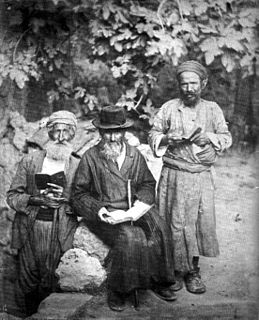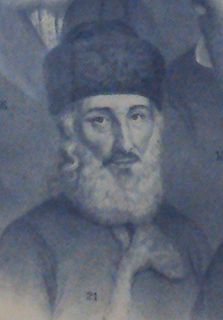Related Research Articles

The Shulchan Aruch, sometimes dubbed in English as the Code of Jewish Law, is the most widely consulted of the various legal codes in Judaism. It was authored in Safed by Joseph Karo in 1563 and published in Venice two years later. Together with its commentaries, it is the most widely accepted compilation of Jewish law ever written.

Hai ben Sherira better known as Hai Gaon, was a medieval Jewish theologian, rabbi and scholar who served as Gaon of the Talmudic academy of Pumbedita during the early 11th century. He was born in 939 and died on March 28, 1038. He received his Talmudic education from his father, Sherira ben Hanina, and in early life acted as his assistant in teaching. In his forty-fourth year he became associated with his father as "av bet din," and with him delivered many joint decisions. According to Sefer HaKabbalah of Rabbi Abraham ben David (Ravad), he was the last of the Geonim.
Yom Tov ben Moshe Tzahalon,, also known as the Maharitz,, was a student of Moses di Trani and Moshe Alshich, and published a collection of responsa.
Judah ben Samuel of Regensburg, also called Yehuda HeHasid or 'Judah the Pious' in Hebrew, was a leader of the Chassidei Ashkenaz, a movement of Jewish mysticism in Germany considered different from the 18th-century Hasidic movement founded by the Baal Shem Tov.

Rabbi Moses Isserles, also known by the acronym Rema, was an eminent Polish Ashkenazic rabbi, talmudist, and posek.
Israel Isserlin was a Talmudist, and Halakhist, best known for his Terumat HaDeshen, which served as one source for HaMapah, the component of the Shulkhan Arukh by Moses Isserles. He is also known as Israel of Neustadt, Israel of Marpurk, and Maharai.

Jacob Berab, also spelled Berav or Bei-Rav,, was an influential rabbi and talmudist best known for his attempt to reintroduce classical semikhah (ordination).
Elijah Mizrachi was a Talmudist and posek, an authority on Halakha, and a mathematician. He is best known for his Sefer ha-Mizrachi, a supercommentary on Rashi's commentary on the Torah. He is also known as Re'em, the Hebrew acronym for "Rabbi Elijah Mizrachi", coinciding with the Biblical name of an animal, sometimes translated as "unicorn".
Rabbi Samuel ben Moses de Medina, was a Talmudist and author from Thessaloniki. He was principal of the Talmudic college of that city, which produced a great number of prominent scholars during the 16th and 17th centuries. His teachers were the noted Talmudists Joseph Taitazak and Levi Ibn Chaviv, and among his schoolmates were Isaac Adarbi, Joseph ibn Leb, and Moses Almosnino. While on a mission to Constantinople he met the noted grammarian Menahem Lonzano, who studied under him for some time and who therefore speaks of him as his teacher.
Samuel Judah Katzenellenbogen was an Italian Rabbi, the son of Rabbi Meir Katzenellenbogen.

David ben Solomon ibn (Abi) Zimra (1479–1573) also called Radbaz (רַדְבָּ"ז) after the initials of his name, Rabbi David iBn Zimra, was an early Acharon of the fifteenth and sixteenth centuries who was a leading posek, rosh yeshiva, chief rabbi, and author of more than 3,000 responsa as well as several scholarly works.
Jacob Weil, later known as Mahariv was a German rabbi and Talmudist who flourished during the first half of the fifteenth century.
Moses ben Isaac Bonems was a 17th-century Polish rabbi and talmudic scholar.
Simḥa ben Samuel of Speyer was a German rabbi and tosafist. Neither the year of his birth nor that of his death is known. He was one of the leading signatories of the Takkanot Shum He was a nephew of the director (parnas) Kalonymus, a student of R. Eliezer of Metz, and a colleague of Eliezer ben Joel ha-Levi.

Judah ben Eliezer ha-Levi Minz, also known as Mahari Minz, was the most prominent Italian rabbi of his time. As his surname suggests, he immigrated around 1462 from Mainz to Italy. He officiated as rabbi of Padua for forty-seven years, during which time he had a great number of pupils, among whom were his son Abraham Minz, and the latter's son-in-law Meir Katzenellenbogen. In a dispute he had with Elia del Medigo, he was supported by Elijah Mizrachi.
Moses ben Mordecai Zacuto, also known by the Hebrew acronym RaMa"Z, was a rabbi, Kabbalist, and poet. Zacuto, who was born into a Portuguese Marrano family in Amsterdam, studied Jewish subjects under Saul Levi Morteira. He also studied secular subjects, such as the Latin language. As a pupil of Morteira, he may also have been, as a youth still in Amsterdam, a fellow student of Baruch Spinoza.
Moshe ben Yonatan Galante, grandson of Moshe Galante, was a 17th-century rabbi at Jerusalem. He served as the first Rishon Le'Zion and was called Magen (מגן) with reference to the initials of his name. Hezekiah da Silva was among his disciples.
Meir ben Isaac Katzenellenbogen was a German rabbi born in Katzenelnbogen.
Abraham ben Judah ha-Levi Minz was an Italian rabbi who flourished at Padua in the first half of the 16th century. Minz studied chiefly under his father, Judah Minz, whom he succeeded as rabbi and head of the yeshiva of Padua. According to Gedaliah ibn Yahya ben Joseph, it was with Abraham Minz that Jacob Pollak had the quarrel which ended in their excommunicating each other; according to most other authorities, the quarrel was with Judah Minz. Ibn Yahya further says that the Italian rabbis believe that Polak and Abraham Minz died on the same day. Minz was the author of a number of decisions that were printed with those of R. Lewa of Ferrara. He was the author also of Seder Gittin ve-Chalitzah, a treatise on divorce and Chalitzah, printed with the responsa of his father and of his son-in-law Meir Katzenellenbogen.

Moses Münz, also known as Maharam Mintz was a Hungarian rabbi. He served as chief rabbi of Alt-Ofen (Óbuda) from 1790 until his death.
References
- ↑ The Rishonim, The Artscroll history series, Pg. 153
 This article incorporates text from a publication now in the public domain : Singer, Isidore; et al., eds. (1901–1906). "Minz". The Jewish Encyclopedia . New York: Funk & Wagnalls.
This article incorporates text from a publication now in the public domain : Singer, Isidore; et al., eds. (1901–1906). "Minz". The Jewish Encyclopedia . New York: Funk & Wagnalls.